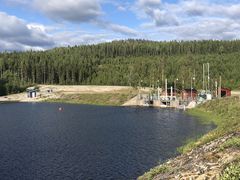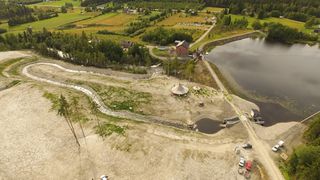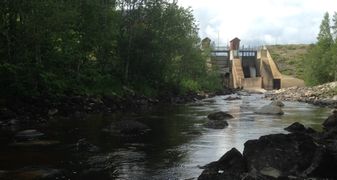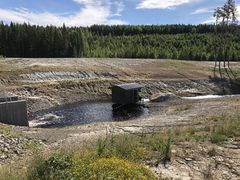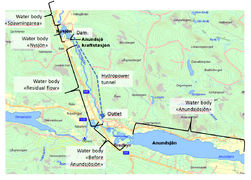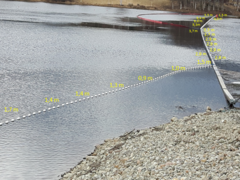Difference between revisions of "Anundsjö test case"
Bendikhansen (talk | contribs) m (Text replacement - "m3" to "m<sup>3</sup>") |
Bendikhansen (talk | contribs) m (Text replacement - "³" to "<sup>3</sup>") |
||
| Line 6: | Line 6: | ||
The Test Case is located on the small river Mo (Moälven) in the northern part of Sweden. The hydrology of the river Mo is typical for north Sweden, with a lot of snow in the winter, a spring flood when the snow melts, reduced flow during the summer and often an autumn flood before the next snow. | The Test Case is located on the small river Mo (Moälven) in the northern part of Sweden. The hydrology of the river Mo is typical for north Sweden, with a lot of snow in the winter, a spring flood when the snow melts, reduced flow during the summer and often an autumn flood before the next snow. | ||
| − | The catchment area is 820 km². Mean precipitation for the whole catchment area is approx. 727 mm per year, with a mean flow at the Baltic sea of 27.9 | + | The catchment area is 820 km². Mean precipitation for the whole catchment area is approx. 727 mm per year, with a mean flow at the Baltic sea of 27.9 m<sup>3</sup>/s and 10.2 m<sup>3</sup>/s at the HPP Anundsjø. |
=About the hydropower plant= | =About the hydropower plant= | ||
| − | The HPP is impounding a small reservoir, releasing the water through the turbines and a tunnel back into the river. It has an installed capacity of 5 MW. The inter-annual discharge is 10 | + | The HPP is impounding a small reservoir, releasing the water through the turbines and a tunnel back into the river. It has an installed capacity of 5 MW. The inter-annual discharge is 10 m<sup>3</sup>/s with a low-water flow of 2.21 m<sup>3</sup>/s. |
===Layout=== | ===Layout=== | ||
A small reservoir of 0.5 ha is located upstream of the HPP Anundsjø. Further upstream are areas of spawning grounds, which are not directly affected by the HPP. Directly downstream of the outlet, a small water body is located, where the river is divided into two. During the winter, a larger reservoir further upstream provides the HPP with water. The river stretch between the dam (inlet) and the outlet is 4 km long. | A small reservoir of 0.5 ha is located upstream of the HPP Anundsjø. Further upstream are areas of spawning grounds, which are not directly affected by the HPP. Directly downstream of the outlet, a small water body is located, where the river is divided into two. During the winter, a larger reservoir further upstream provides the HPP with water. The river stretch between the dam (inlet) and the outlet is 4 km long. | ||
| Line 25: | Line 25: | ||
The downstream migration device consisted of a floating guidance, attached right next to the intake, leading the fish into a smolt trap and then out to the downstream side of the dam. The new license of 2012 states that this device shall be placed out 1/5 every year and water released in the smolt trap shall be 0.25 m<sup>3</sup>/s. This solution was evaluated together with the authorities after the first year, 2016, and the conclusion was that it did not work as intended. 2017 a new solution was tested, with fishing nets, leading the smolts to the fish way instead. The water to the smolt trap should instead go through the fish way and the date for placement is moved to a flexible time due to when ice is gone from the reservoir. | The downstream migration device consisted of a floating guidance, attached right next to the intake, leading the fish into a smolt trap and then out to the downstream side of the dam. The new license of 2012 states that this device shall be placed out 1/5 every year and water released in the smolt trap shall be 0.25 m<sup>3</sup>/s. This solution was evaluated together with the authorities after the first year, 2016, and the conclusion was that it did not work as intended. 2017 a new solution was tested, with fishing nets, leading the smolts to the fish way instead. The water to the smolt trap should instead go through the fish way and the date for placement is moved to a flexible time due to when ice is gone from the reservoir. | ||
===Upstream migration=== | ===Upstream migration=== | ||
| − | The upstream migrating fish encounter the outlet, located 4 km downstream the fishway. The attraction flow is represented by the minimum flow, 0.8 | + | The upstream migrating fish encounter the outlet, located 4 km downstream the fishway. The attraction flow is represented by the minimum flow, 0.8 m<sup>3</sup>/s between the 15th of July and the 5th of October; 0.25 m<sup>3</sup>/s the rest of the year. At the end of the 4 km long residual area the upstream migration continues in the fish way. Through the dam there is a fish ladder made in concrete. |
===E-flow=== | ===E-flow=== | ||
In the new license from 2012 the requirements are release of water in fish way between the 15th of July and the 5th of October 0.8 m<sup>3</sup>/s and the rest of the year 0.25 m<sup>3</sup>/s. During the same period one hour every Tuesday and Thursday the power plant must shut down and release the discharge through the gates in order to attract salmon up in the residual area. | In the new license from 2012 the requirements are release of water in fish way between the 15th of July and the 5th of October 0.8 m<sup>3</sup>/s and the rest of the year 0.25 m<sup>3</sup>/s. During the same period one hour every Tuesday and Thursday the power plant must shut down and release the discharge through the gates in order to attract salmon up in the residual area. | ||
Revision as of 10:21, 21 February 2020
| Fact box: Anundsjö | |
|---|---|
| Country | Sweden |
| River | Mo (Moälven) |
| Operator | Statkraft |
| Capacity | 5 MW |
| Head | 61 m |
| Inter-annual discharge | 10 m3/s |
| Turbine(s) | 1 Francis turbine |
| Detailed report | Click for pdf |
Contents
Introduction
The Test Case is located on the small river Mo (Moälven) in the northern part of Sweden. The hydrology of the river Mo is typical for north Sweden, with a lot of snow in the winter, a spring flood when the snow melts, reduced flow during the summer and often an autumn flood before the next snow.
The catchment area is 820 km². Mean precipitation for the whole catchment area is approx. 727 mm per year, with a mean flow at the Baltic sea of 27.9 m3/s and 10.2 m3/s at the HPP Anundsjø.
About the hydropower plant
The HPP is impounding a small reservoir, releasing the water through the turbines and a tunnel back into the river. It has an installed capacity of 5 MW. The inter-annual discharge is 10 m3/s with a low-water flow of 2.21 m3/s.
Layout
A small reservoir of 0.5 ha is located upstream of the HPP Anundsjø. Further upstream are areas of spawning grounds, which are not directly affected by the HPP. Directly downstream of the outlet, a small water body is located, where the river is divided into two. During the winter, a larger reservoir further upstream provides the HPP with water. The river stretch between the dam (inlet) and the outlet is 4 km long.
The Operator: Statkraft
Statkraft is a leading company in hydropower internationally and Europe’s largest generator of renewable energy. The Group produces hydropower, wind power, solar power, gas-fired power and supplies district heating. Statkraft is a global company in energy market operations. It is Norway's largest and the Nordic region's second largest power producer. Read more.
Pressures on the water body's ecosystem
Due to two dams downstream of the HPP, for which the fish passage efficiency is unknown, the continuity is moderate. Most parts of the rapids have been modified for timber floating, with only a few being restored. Furthermore, the hydrology directly downstream of the HPP is affected by short-time regulation and variations of the upper water level in the small reservoir by up to 0.5 m. A recurring problem in Sweden is pollution through Mercury, which is released from the ground through logging activities, causing a moderate pollution of the water body.
Test case topics
Fish population
The fish species that can be found in the Mo are: salmon, sea trout, grayling, pike, perch, brown trout and crayfish. During the summer from July to October, the power plant is shut down twice a week for an hour, releasing the discharge through the gates in order attract salmon into the residual area.
Downstream migration
The downstream migration device consisted of a floating guidance, attached right next to the intake, leading the fish into a smolt trap and then out to the downstream side of the dam. The new license of 2012 states that this device shall be placed out 1/5 every year and water released in the smolt trap shall be 0.25 m3/s. This solution was evaluated together with the authorities after the first year, 2016, and the conclusion was that it did not work as intended. 2017 a new solution was tested, with fishing nets, leading the smolts to the fish way instead. The water to the smolt trap should instead go through the fish way and the date for placement is moved to a flexible time due to when ice is gone from the reservoir.
Upstream migration
The upstream migrating fish encounter the outlet, located 4 km downstream the fishway. The attraction flow is represented by the minimum flow, 0.8 m3/s between the 15th of July and the 5th of October; 0.25 m3/s the rest of the year. At the end of the 4 km long residual area the upstream migration continues in the fish way. Through the dam there is a fish ladder made in concrete.
E-flow
In the new license from 2012 the requirements are release of water in fish way between the 15th of July and the 5th of October 0.8 m3/s and the rest of the year 0.25 m3/s. During the same period one hour every Tuesday and Thursday the power plant must shut down and release the discharge through the gates in order to attract salmon up in the residual area.
Research objectives and tasks
The overall question at the HPP Anundsjø is how FIThydro can improve the situation for fish by different measures and means around the HPP. This includes the situation for the smolt, which are mainly arriving at the HPP after being released in the upstream area. It also includes the situation of juvenile fish of different species as well as the possibility for salmon to pass on the way to spawn and back (influenced also by the HPP located downstream of Anundsjø and influencing especially the number of migrating fish.
Research tasks
The research tasks and field studies conducted at Anundsjö are:
- Bathymetry and velocity in reservoir
- Bathymetry of the fishway and the entrance with GPS and drone flights for Structure for Motion (SfM)
- Bathymetry, flow velocity data and drone flights for SfM and habitat in bypassed river reach
